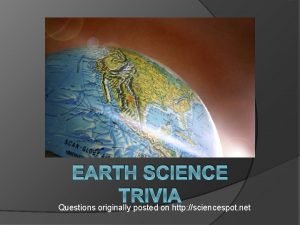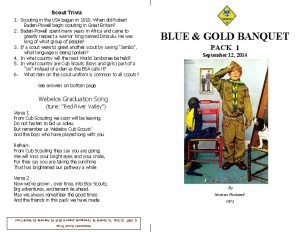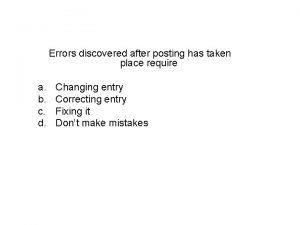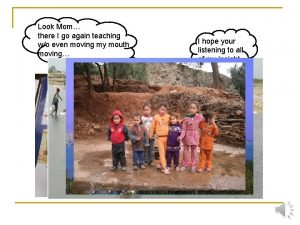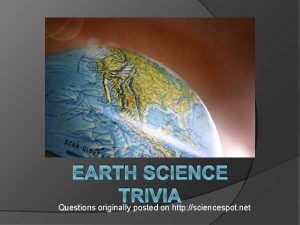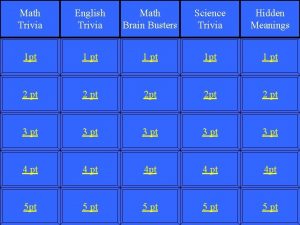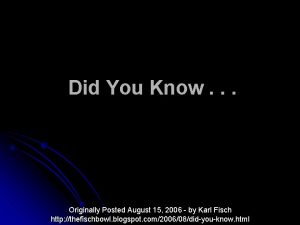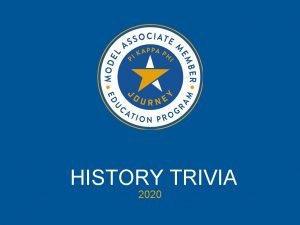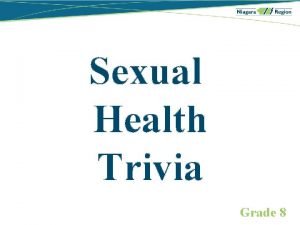EARTH SCIENCE TRIVIA Questions originally posted on http



















- Slides: 19

EARTH SCIENCE TRIVIA Questions originally posted on http: //sciencespot. net

Earth Science Trivia - A 1. Are Europe and North America drifting closer together or farther apart? A. Closer B. Farther 2. Which is the largest body of water on Earth? A. Pacific Ocean B. Atlantic Ocean 3. Which does not belong? A. Shale C. Sandstone B. Basalt D. Limestone

Earth Science Trivia - A 1. Are Europe and North America drifting closer together or farther apart? A. Closer B. Farther 2. Which is the largest body of water on Earth? A. Pacific Ocean B. Atlantic Ocean 3. Which does not belong? A. Shale C. Sandstone B. Basalt (Igneous Rock) D. Limestone

Earth Science Trivia - B 4. Mammoth Caves in Kentucky is the longest cave system in the world. How long is it? A. 400 km B. 480 km C. 550 km 5. Which imaginary lines circles the earth below the equator (Southern Hemisphere)? A. Tropic of Cancer B. Tropic of Capricorn 6. How many times a day do high tides occur around the world? A. One B. Two C. Four D. Ten

Earth Science Trivia - B 4. Mammoth Caves in Kentucky is the longest cave system in the world. How long is it? A. 400 km B. 480 km C. 550 km 5. Which imaginary lines circles the earth below the equator (Southern Hemisphere)? A. Tropic of Cancer B. Tropic of Capricorn 6. How many times a day do high tides occur around the world? A. One B. Two C. Four D. Ten

Earth Science Trivia - C 7. There about 9 million cubic miles of ice on Earth. Is most of it located near: A. the North pole B. the South pole 8. On a map, are the lines that run parallel to the equator called: A. Longitude B. Latitude 9. If it is 2: 00 pm in New York City, what time is it in Los Angeles, California? A. 11: 00 am B. Noon C. 1: 00 pm D. 2: 00 pm

Earth Science Trivia - C 7. There about 9 million cubic miles of ice on Earth. Is most of it located near: A. the North pole B. the South pole 8. On a map, are the lines that run parallel to the equator called: A. Longitude B. Latitude 9. If it is 2: 00 pm in New York City, what time is it in Los Angeles, California? A. 11: 00 am B. Noon C. 1: 00 pm D. 2: 00 pm

Earth Science Trivia - D 10. Is the water in the ocean colder at the surface or 50 feet below the surface? A. At the surface B. 50 feet below 11. Olympus Mons is a volcano almost three times as tall as Mount Everest. Is it found on: A. Earth B. Mars C. Venus 12. What percent of the world’s population live in the United States? A. 6% B. 12% C. 18% D. 24%

Earth Science Trivia - D 10. Is the water in the ocean colder at the surface or 50 feet below the surface? A. At the surface B. 50 feet below 11. Olympus Mons is a volcano almost three times as tall as Mount Everest. Is it found on: A. Earth B. Mars C. Venus 12. What percent of the world’s population live in the United States? A. 6% B. 12% C. 18% D. 24%

Earth Science Trivia - E 13. Is Earth the second, third, or fourth planet from the sun? Choose: 2 nd, 3 rd, or 4 th 14. Which formation in a cave rise from the floor: A. stalagmites B. stalactites 15. When magma cools and hardens, it forms: A. Igneous rock B. Sedimentary rock C. Metamorphic rock

Earth Science Trivia - E 13. Is Earth the second, third, or fourth planet from the sun? Choose: 2 nd, 3 rd, or 4 th 14. Which formation in a cave rise from the floor: A. stalagmites B. stalactites 15. When magma cools and hardens, it forms: A. Igneous rock B. Sedimentary rock C. Metamorphic rock

Earth Science Trivia - F 16. In March, Daylight Savings Time begins. We: A. set our clocks ahead 1 hour B. set them back 1 hour 17. Which is the deepest ocean? A. Atlantic Ocean B. Indian Ocean C. Arctic Ocean D. Pacific Ocean 18. The longest river on Earth is: A. Mississippi B. Nile C. Amazon

Earth Science Trivia - F 16. In March, Daylight Savings Time begins. We: A. set our clocks ahead 1 hour B. set them back 1 hour 17. Which is the deepest ocean? A. Atlantic Ocean B. Indian Ocean C. Arctic Ocean D. Pacific Ocean 18. The longest river on Earth is: A. Mississippi B. Nile C. Amazon

Earth Science Trivia - G 19. 20. 21. Which of the following is classified as metamorphic rock? A. Basalt B. Marble C. Shale How long does it take the light from the sun to reach us? A. 2 minutes B. 6 minutes C. 8 minutes D. 10 minutes Which of the following is the oldest mountain range on Earth? A. Rockies (in N. America) B. Andes (in S. America) C. Highlands (in Scotland)

Earth Science Trivia - G 19. 20. 21. Which of the following is classified as metamorphic rock? A. Basalt B. Marble C. Shale How long does it take the light from the sun to reach us? A. 2 minutes B. 6 minutes C. 8 minutes D. 10 minutes Which of the following is the oldest mountain range on Earth? A. Rockies (in N. America) B. Andes (in S. America) C. Highlands (in Scotland)

Earth Science Trivia - H 22. Which is larger ? A. Pacific Ocean B. Atlantic Ocean C. Continent of Asia D. Continent of Antarctica 23. Complete this statement: The moon's diameter is ____ the size of Earth's diameter. A. 1/8 B. 1/4 C. 1/2 24. How many degrees does the Earth turn in one day? A. 90 B. 180 C. 360

Earth Science Trivia - H 22. Which is larger ? A. Pacific Ocean B. Atlantic Ocean C. Continent of Asia D. Continent of Antarctica 23. Complete this statement: The moon's diameter is ____ the size of Earth's diameter. A. 1/8 B. 1/4 C. 1/2 24. How many degrees does the Earth turn in one day? A. 90 B. 180 C. 360

Earth Science Trivia - I 25. In March and September, the sun is directly over the equator. These are: A. Equinoxes B. Solstices 26. Which of the following is the longest mountain range on Earth? A. Andes (in S. America) B. Rockies (in N. America) C. Great Dividing Range (in Australia) 27. What percent of the people on Earth live north of the Equator? A. 40% B. 60% C. 80%

Earth Science Trivia - I 25. In March and September, the sun is directly over the equator. These are: A. Equinoxes B. Solstices 26. Which of the following is the longest mountain range on Earth? A. Andes (in S. America) B. Rockies (in N. America) C. Great Dividing Range (in Australia) 27. What percent of the people on Earth live north of the Equator? A. 40% B. 60% C. 80%
 Earth science trivia
Earth science trivia Nuts and volts hunger games
Nuts and volts hunger games 1950's music trivia questions and answers
1950's music trivia questions and answers Technology trivia questions for students
Technology trivia questions for students Fbla trivia questions
Fbla trivia questions Boy scout trivia
Boy scout trivia President trivia questions for kids
President trivia questions for kids Originally carol ann duffy questions
Originally carol ann duffy questions Originally carol ann duffy questions
Originally carol ann duffy questions Mathematics ____ my favorite subject.
Mathematics ____ my favorite subject. What is an infrared thermometer best used for servsafe
What is an infrared thermometer best used for servsafe When installing tabletop equipment on legs
When installing tabletop equipment on legs Impulse physics examples
Impulse physics examples After posting is completed there may be an error if
After posting is completed there may be an error if Which column totals of a journal are posted?
Which column totals of a journal are posted? Posted voucher rack
Posted voucher rack Look mom i posted it again
Look mom i posted it again Http //mbs.meb.gov.tr/ http //www.alantercihleri.com
Http //mbs.meb.gov.tr/ http //www.alantercihleri.com Siat ung sistem informasi akademik
Siat ung sistem informasi akademik Camping trivia
Camping trivia
